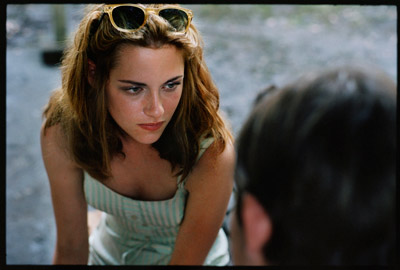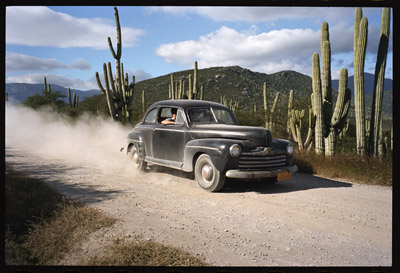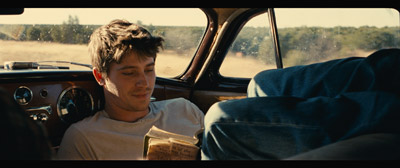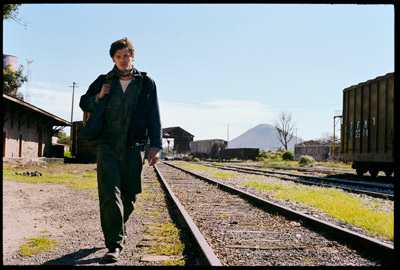Walter Salles On the Road Interview

Walter Salles On the Road Interview
Cast: Garrett Hedlund , Kristen Stewart, Sam RileyDirector: Walter Salles
Genre: Drama
Running Time: 137 minutes
Synopsis: Starring Sam Riley, Kristen Stewart, Kirsten Dunst, Garrett Hedlund, Amy Adams, Steve Buscemi and Viggo Mortensen and directed by Walter Salles, On the Road is based on the seminal beatnik novel by Jack Kerouac, about a young man who sets out to travel the roads and railways of America.
Release Date: September 27th, 2012
Interview with Walter Salles
Question: Do you remember how you felt the first time you read On the Road?Walter Salles: I read the book at a difficult time in Brazil, the years of the military regime. Censorship affected the press, the publishing houses, music and cinema. 'On the Road' wasn't published in Brazil at the time, and I had to read it in English. I was immediately taken by the freedom of the characters, by the Jazz-infused narrative, by the way sex and drugs could be seen as instruments to expand our understanding of the world. It was the exact reverse angle of what we were living. So Kerouac's vision caused a profound impression on me, and on many other people of my generation as well. Symptomatically, On the Road was published in Brazil in 1984, when the country was moving back towards democracy. The book was so emblematic for me that the idea of adapting it for the screen didn't initially occur to me.
Question: More largely, what are your affinities with the Beat Generation?
Walter Salles: I was a teenager in the late 1960s and early 1970s. For people of my generation, it wasn't difficult to understand that most of the liberation movements we were witnessing or taking part of when we were 20 had their roots in the generation of Ginsberg, Kerouac, Snyder, di Prima, or Baraka. They had quite simply redefined the culture from within. Michael McClure, who was part of the movement, expresses it more clearly than I: "The other day, a young guy about 21 asked me what happened to the Beat Generation. He dressed the way he wanted, wore his hair the way he wanted, was against the war in Iraq, and interested in ecology and Buddhism. I asked him the same question: "Yeah, where's the Beat Generation?"
Question: In your work-in-progress documentary Searching For On the Road, you talk about all the research you did before starting the shoot. Why was this such an important step for you?
Walter Salles: When the initial conversations with American Zoetrope took place in 2004, I didn't feel ready. The possibility of the adaptation was so complex that I proposed to shoot a documentary first, following the steps that Kerouac and the rest of the group took, trying to better understand the odyssey described in the book. I was also aiming to gain a more in-depth perspective of the issues facing that generation, the social political context of the late 40s, early 50s. Last, I shot the documentary because I wished I'd filmed what we'd experienced when we were scouting locations in Latin America for The Motorcycle Diaries. These are unique moments that will never be reproduced; it's as simple as that.
 Question: Which version of On the Road did you and your co-writer Jose Rivera use for the screenplay?
Question: Which version of On the Road did you and your co-writer Jose Rivera use for the screenplay? Walter Salles: In Lowell, Massachusetts, a town where Kerouac spent much of his childhood and adolescence, we met John Sampas, Jack's brother-in-law. He was very generous and showed me a copy of the original scroll.
I was immediately struck by the urgency and immediacy of this version. The first sentence already heralded a different type of narrative. The version published in 1957 began: "I met Dean not long after my wife and I split up." The scroll begins differently, "I first met Neal not long after my father died." The hero of the scroll has just suffered a loss that compels him to go forward. The search for a father is a vital theme in the scroll, even more so than in the version published in 1957. This is a theme that has always interested me, and it became one of the motors driving the adaptation. For five years, Jose and I worked with and talked about many different versions. We tried to respect the book as much as possible. Sometimes we deviated from it - betraying it to be more faithful to it. An adaptation should incite the audience to return to the book, the original version. And to construct their own versions of On the Road.
Question: Kerouac writes in a lush, lyrical, and opulent style. How far did you stray from Kerouackian language?
Walter Salles: On the Road is sometimes seen as a narrative circumscribed to what has been lived. But, like many, I believe that the book's originality lies in the coexistence of what has been experienced, and what has been imagined. Here's an example: Kerouac describes William Burroughs' house in New Orleans as an old, decaying, Southern colonial mansion. In reality, the house where Burroughs hosted Kerouac and Cassady in Algiers is quite different: a small wooden structure, nested on a calm street. It didn't have an orgone accumulator as described in On the Road. But it doesn't matter, because the old mansion and the orgone accumulator were part of other tales about Burroughs that Kerouac had heard from Ginsberg, when Allen and Neal went to his farm in Texas, and he integrated them into On the Road. The book transcends the factual report. It is the product of a unique ability to link what has been experienced with elements created by an endlessly creative imagination. This is the spirit we tried to be faithful to.
Question: 'On the Road' is full of contradictions. Radical freedom is touted on one page, whereas the next may be far more conservative. In particular, the book has been criticized for misogyny. How did you overcome this dichotomy?
Walter Salles: Like all great books, On the Road elicits different reactions, depending on the reader's point of view. If you read Barry Gifford's wonderful oral biography of Kerouac, "Jack's Book", you'll see how the same scene allows for different interpretations, like Kurosawa's "Rashomon". Some believe that the book can be seen as misogynistic. But I also spoke to young women who see the Marylou character as a woman who's way ahead of her time, a teenager who implodes the sexual taboos of the 50s, and acts in manners that were forbidden in puritanical post-war America. Others see Camille/Carolyn as a silent heroine, a woman who supports a whole family while Neal/Dean is exploring the world with Jack/Sal. If the female characters are more present in the film than in the book, it is precisely because of this controversy.
Question: Your films, like many other road movies, often involve two people travelling together. How did you set up the Sal-and-Dean duo?
Walter Salles: Kerouac gives you a clear understanding of their relationship. Dean is the instigator, the incendiary, the "Western wind" who upsets all the convictions held by the group of New York intellectuals that Kerouac and Allen were part of before Dean landed in New York. Neal/Dean is so intriguing that he is the central character not only of several books by Kerouac, but also of Go by John Clellon Holmes, and of several of Ginsberg's poems. Sal is a sensitive observer, one who expresses in words the breath of freedom that Dean brings, enabling us to share it. When I was making the documentary, I sometimes heard people criticise Neal for selfishly taking advantage of his friends. But one might wonder who took advantage of whom, ultimately. In fact, this fascinating question is in the film.
Question: The wide open spaces are a prominent part of On the Road. How did you and Éric Gautier plan the cinematography?
Walter Salles: Physical geography is at the heart of the book, but less than what might be called the characters' internal geography. In one of her essays on On the Road, Ann Charters says that the book can also be understood as a story about the end of the road. The United States were defined on the basis of this westward journey. It's no accident if the Western is the quintessential North American film genre. The end of the conquest of the West signaled the beginning of the end of the American dream, and the characters in On the Road carry this dichotomy within themselves. We were especially interested in filming this desire to reveal what was unknown to them, alongside their inner conflicts. From the beginning, Éric Gautier, with his brilliantly sharp eye, understood the paradox. He is on the lookout, camera in hand, for the characters and their oscillations. As Éric pointed out, shooting On The Road in black and white would have been mere fulfilment of expectation, a citation of Robert Frank's The Americans. I'd rather keep black and white for a contemporary film - something I did in Fore Ignland, a film about the 1990s in Brazil.
Question: Your adaptation of On the Road follows a rhythm similar to the one in the book, alternating moments of introspection and acceleration. Could your film be regarded as a "making-of" about itself?
Walter Salles: The book contains the same duality. On the one hand, you have the urgency of a generation exploring all the senses, living to Be-bop and Benzedrine tempos. The improvisational quality of Jazz resounds throughout the book. On the other hand, you have the contemplation and introspection that are unique to Kerouac. We've tried to express this to-and-fro motion in the film. But a film is also impregnated by what we experience during the shoot as a family: moments of happiness, doubt, joy, despair. Shooting The Motorcycle Diaries was not easy, but On The Road was ten times harder. For one thing, South America is still a last frontier, whereas the North American frontier has been polluted with Wal-Marts and suburban sprawl. We had to go a long way, sometimes a very long way, to achieve the sensation of finding new territory.
Question: Although jazz is the lifeblood of On the Road, it has influenced generations of rockers. Do the characters in your film do the jitterbug, or pop their fingers to be-bop?
Walter Salles: For The Motorcycle Diaires, composer Gustavo Santaolalla had worked upstream, composing themes that inspired us throughout the shoot. On The Road got off to a sudden start thanks to MK2's young producers Nathanaël Karmitz and Charles Gillibert, so quickly that we didn't have time to prepare the soundtrack beforehand, except for a Slim Gaillard song. So Gustavo worked as we were shooting and editing, before seeing the images. This process creates a gap between the image and the music which I find more interesting. Music ceases to underline the image. When you have someone as talented as Gustavo collaborating with you, you'd better take advantage of it! For the music, Gustavo worked with brilliant musicians like Charlie Haden and Brian Blade, and the recording sessions in Los Angeles were truly blissful. I'm very fond of the Liberation Music Orchestra that Haden leads, and Charlie is a pretty incredible storyteller�
 Question: On the Road' tells the story of youth burning like candles in the night - but it also encompasses moments of joy, reflected in the exuberant dance sequences. How did you make sure the actors' playing brought out these waves of energy?
Question: On the Road' tells the story of youth burning like candles in the night - but it also encompasses moments of joy, reflected in the exuberant dance sequences. How did you make sure the actors' playing brought out these waves of energy? Walter Salles: Yes, the characters in the book burn, burn, burn like Roman candles� How can this energy be represented onscreen? In the characters' body language and gestures, in the constant motion that defines the film, in moments of ecstasy like the dancing scenes. But we also had to find interludes of silence and contemplation, to contrast with the sequences that were defined by a fast tempo.
Question: How did you approach casting the film?
Walter Salles: The cast was constituted over the years, starting in 2004 and 2005. Kirsten Dunst was the first actress I spoke to, with Camille in mind. I always find her acting incredibly precise, nothing is unnecessarily underlined� For Kristen Stewart, things happened in an unforeseen way. Gustavo Santaolalla and Alejandro Iñárritu had just seen a first cut of Into The Wild, and they told me, "Don't look any further for Marylou. The girl is in the new Sean Penn film, and she is fantastic." I saw Penn's film, which I truly loved, and met Kristen just before the Twilight madness started. She knew the book extremely well, and she understood Marylou. Kristen stayed committed to the film during all the years of uncertainty. As for Garrett, he came in for a test. He asked to read a text he'd written while riding a bus from Minnesota to Los Angeles, stopping in nude-bars and so forth. By the time he'd gotten half-way through, I knew he would be Dean. Garrett also waited for years. Whenever he got an offer for another film, he would call first. A friendship emerged from the trust we had in each other, as it did with Gael García Bernal. Tom Sturridge also did a great test for us, reading for Carlo. I remember everyone in the room being so taken by it. When I saw Control, I was very impressed by Sam Riley's performance as Ian Curtis. It was simply brilliant. He came to read with Garrett in New York, and I was profoundly moved by his humanity and intelligence, as well as his precision as an actor. These were the qualities necessary to play a writer. Closer to the shoot, Viggo joined us to play Bull Lee, as well as Amy Adams. They are both genius actors, who can morph into any character seamlessly, and grant them an incredible inner life. When Viggo came to New Orleans, he brought the typing machine Burroughs was using at the time, the same guns, and he had done extensive research on what Burroughs was reading in 1949. It happened to be the Mayan Codes and the works of Celine. The improvisation on Celine in the film is a suggestion brought by Viggo. He's one of the co-authors of the film.
Question: You decided to have the actors playing the leading roles gather in a "beatnik camp" prior to the shoot. Why?
Walter Salles: It's an experiment we've been carrying out since Fore Ignland. The idea is to create a community before we begin creating the film. Barry Gifford, who wrote the great "Jack's book" and had researched On the Road and Kerouac's work thoroughly, came to the camp to talk to us about the book and its characters. He was extremely generous with us. Barry had interviewed LuAnne Henderson, and listening to the recordings he made with her was a big help to Kristen. LuAnne's daughter, Anne Marie Santos, also visited and brought a weath of photos and information about her mother. It was very moving to see her with Kristen. Just as when Neal Cassady's son John came to see us. He was incredibly generous with Garrett, and communicated something fundamental to us: On the Road is not a story about the Beat Generation. It's a story about young men, 18, 20 years old, mostly sons of immigrants who don't find their place in the conservative America of the late 40s and 50s and collide against it, ultimately changing the culture from within. On the Road is the moment before the eruption, the lava forming and boiling under the surface, about to emerge� it's about the formative years of a brilliant generation. There you go, here's another parallel with The Motorcycle Diaires.
 Question: In your opinion, where does Kerouac's modernity lie?
Question: In your opinion, where does Kerouac's modernity lie? Walter Salles: In the desire to explore everything in the flesh. To feel, smell, taste, live every moment to the fullest- and not vicariously, on a screen. When I was shooting the documentary, we were driving with Lawrence Ferlinghetti around San Francisco. He looked at the jammed up Bay Bridge to Berkeley and uttered a sentence I will never forget: "You see, there's no more away." When On the Road was written, the world had yet to be mapped completely. Borges used to say that his greatest pleasure in literature was to name what had yet to be named. Today, we get the impression everything has already been done or explored. Chinese director Jia Zhang-Ke beautifully expresses this implosion of space and time in his film The World. It ends, symptomatically, with the suicide of the young hero and heroine. On the Road is like an antidote to this immobility. That's what fascinates me the most about the book.
Question: The Hudson is one of the key characters in On the Road. It is the setting for arguments, desires, encounters, etc.
Walter Salles: Ah, the Hudson� It really is a fullfledged character, like "La Poderosa" in The Motorcycle Diaires. So many key moments in the film happen in the car, which can also be seen as what a "huis-clos". We covered thousand of miles with it, nonstop, shooting first unit scenes or driving around the United States for the second unit. People recognised the car, and came up to us to talk about it. This is when we realised that the Hudson has a cult following, and that enabled us to meet some unique individuals. Many of them were colorful mechanics, let's admit it� I've always loved Steve McQueen's films, partly because of his highly intelligent restraint as an actor, but also for his awesome skill as a driver. Garrett has some of his qualities. He is one with the car, so we were able to shoot scenes with the actors moving at speeds that were� how can I say it� not exactly legal, but so much in the spirit of Neal Cassady and Dean Moriarty.
Interview by Auréliano Tonet (The completer interview can be found in Trois Couleurs magazine Special Issue #8)
MORE
- Mission: Impossible Fallout
- Glenn Close The Wife
- Allison Chhorn Stanley's Mouth Interview
- Benicio Del Toro Sicario: Day of the Soldado
- Dame Judi Dench Tea With The Dames
- Sandra Bullock Ocean's 8
- Chris Pratt Jurassic World: Fallen Kingdom
- Claudia Sangiorgi Dalimore and Michelle Grace...
- Rachel McAdams Disobedience Interview
- Sebastián Lelio and Alessandro Nivola...
- Perri Cummings Trench Interview



